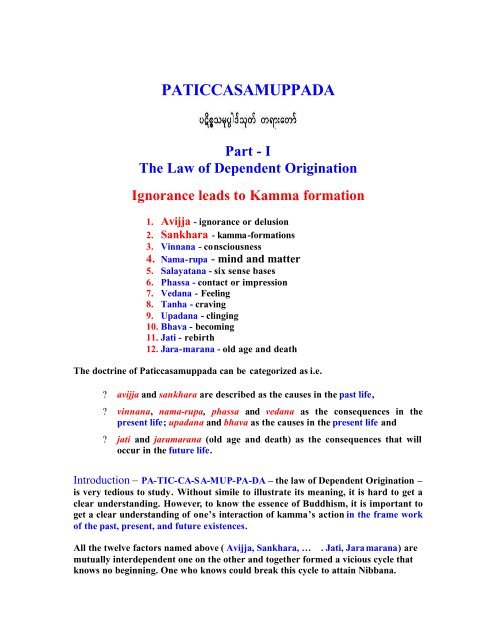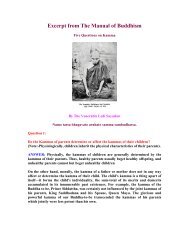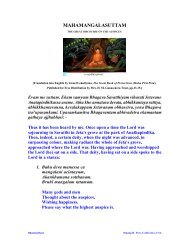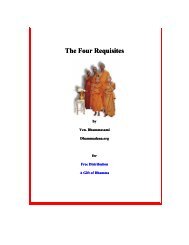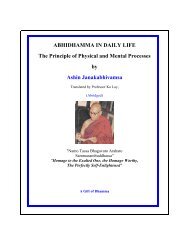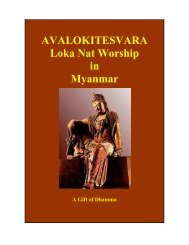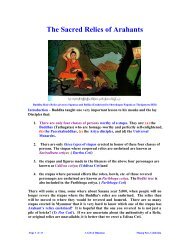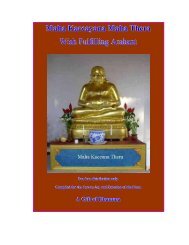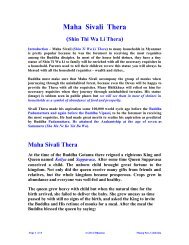Explanation Avija Sankhara-PATICCA ... - Usamyanmar.net
Explanation Avija Sankhara-PATICCA ... - Usamyanmar.net
Explanation Avija Sankhara-PATICCA ... - Usamyanmar.net
You also want an ePaper? Increase the reach of your titles
YUMPU automatically turns print PDFs into web optimized ePapers that Google loves.
<strong>PATICCA</strong>SAMUPPADA<br />
Part - I<br />
The Law of Dependent Origination<br />
Ignorance leads to Kamma formation<br />
1. Avijja - ignorance or delusion<br />
2. <strong>Sankhara</strong> - kamma-formations<br />
3. Vinnana - consciousness<br />
4. Nama-rupa - mind and matter<br />
5. Salayatana - six sense bases<br />
6. Phassa - contact or impression<br />
7. Vedana - Feeling<br />
8. Tanha - craving<br />
9. Upadana - clinging<br />
10. Bhava - becoming<br />
11. Jati - rebirth<br />
12. Jara-marana - old age and death<br />
The doctrine of Paticcasamuppada can be categorized as i.e.<br />
? avijja and sankhara are described as the causes in the past life,<br />
? vinnana, nama-rupa, phassa and vedana as the consequences in the<br />
present life; upadana and bhava as the causes in the present life and<br />
? jati and jaramarana (old age and death) as the consequences that will<br />
occur in the future life.<br />
Introduction – PA-TIC-CA-SA-MUP-PA-DA – the law of Dependent Origination –<br />
is very tedious to study. Without simile to illustrate its meaning, it is hard to get a<br />
clear understanding. However, to know the essence of Buddhism, it is important to<br />
get a clear understanding of one’s interaction of kamma’s action in the frame work<br />
of the past, present, and future existences.<br />
All the twelve factors named above ( Avijja, <strong>Sankhara</strong>, … . Jati, Jaramarana) are<br />
mutually interdependent one on the other and together formed a vicious cycle that<br />
knows no beginning. One who knows could break this cycle to attain Nibbana.
IGNORANCE AND ILLUSION<br />
If you do not know the truth, then you are obviously ignorant of the true facts.<br />
Those who do not know the four noble truths you may be leading a life with no<br />
specific goal.<br />
The Four Noble Truths:<br />
1. The Noble Truth of Suffering:<br />
2. The Noble Truth of the Cause of Suffering:<br />
3. The Noble Truth of the Annihilation of Suffering:<br />
4. The Truth of the Path leading to the Annihilation of Suffering:<br />
The Noble Eight-fold Path:<br />
1. Right Understanding {Samma-ditthi} Wisdom Group<br />
2. Right Thought { Samma-sankappa } Pañña<br />
3. Right speech { Samma-vaca}<br />
4. Right Action { Samma-kammanta } Morality Virtue<br />
5. Right Livelihood { Samma-ajiva} Group Sila<br />
6. Right Effort { Samma-vayama} Mental Culture<br />
7. Right Mindfulness { Samma-sati} Concentration<br />
8. Right Concentration { Samma-samadhi} Group Samadhi<br />
In the practice of Vipassana meditation, Buddhist believe the two laws as absolute<br />
TRUTH.<br />
In the practice of vipassana the yogi must be absorbed in the Universal truth of -<br />
Universe – Anicca – Impermanence of all things; Dukha – all things leads us to<br />
nothing but sufferings; Anatta – there is nothing that we can identify with and is<br />
called no-self. Meditator must contemplate on this Universal Law of impermanence.<br />
To escape from the cycle of birth and rebirths, there are three things an individual<br />
must be equipped with - Sila (Precepts); Samdhi (Concentration); and Panna<br />
(Vipassana Wisdom). Meditator must gradually cultivate in the perception of the<br />
law of impermanence.<br />
In cultivating Sila, the story of Visakha illustrates, the way we should give donation<br />
of charity or alms to Sangha.<br />
The Story of Visakha (Withakha Yahan Ama)
Dhammapada Verse 53<br />
The Story of Visakha<br />
While residing at the Pubbarama monastery in Savatthi, the Buddha uttered Verse<br />
(53) of this book, with reference to Visakha, the famous donor of the Pubbarama<br />
monastery.<br />
Visakha was the daughter of a rich man of Bhaddiya, named Danancaya, and his<br />
wife Sumanadevi, and the granddaughter of Mendaka, one of the five extremely<br />
wealthy men of' King Bimbisara's dominions. When Visakha was seven years old,<br />
the Buddha came on a tour to Bhaddiya. On that occasion, the rich man Mendaka<br />
took Visakha and her five hundred companions with him to pay homage to the<br />
Buddha. After hearing the discourse given by the Buddha, Visakha, her grandfather<br />
and all her five hundred companions attained Sotapatti Fruition.<br />
When Visakha came of age, she married Punnavadahana, son of Migara, a fairly<br />
rich man from Savatthi. One day, while Migara was having his meal, a bhikkhu<br />
stopped for alms at his house; but Migara completely ignored the bhikkhu. Visakha,<br />
seeing this, said to the bhikkhu, "I am sorry, your reverence, my father-in-law only<br />
eats leftovers." On hearing this, Migara flew into a rage and told her to leave his<br />
house. But Visakha said she was not going away, and that she would send for the<br />
eight elderly rich men who were sent by her father to accompany her and to advise<br />
her. It was for them to decide whether she was guilty or not. When the elders came,<br />
Migara said to them, "While I was having my rice-with-milk in a golden bowl,<br />
Visakha said that I was taking only dirt and filth. For this offence, I'm sending her<br />
away."<br />
Thereupon, Visakha explained as follows: "When I saw my father-in-law completely<br />
ignoring the bhikkhu standing for alms-food, I thought to myself that my father-inlaw<br />
was not doing any meritorious deed in this existence. He was only eating the<br />
fruits of has past good deeds. So, I said, 'My father-in-law only eats leftovers.' Now<br />
Sirs, what do you think, am I guilty?" The elders decided that Visakha was not<br />
guilty. Visakha then said that she was one who had absolute and unshakable faith in<br />
the Teaching of the Buddha and so could not stay where the bhikkhus were not<br />
welcome; and also, that if she was not given permission to invite the bhikkhus to the<br />
house to offer alms-food and make other offerings, she would leave the house. So<br />
permission was granted her to invite the Buddha and his bhikkhus to the house.<br />
The next day, the Buddha and his disciples were invited to the house of Visakha<br />
When alms-food was about to be offered, she sent word to her father-in-law to join<br />
her in offering food; but he did not come. When the meal was over, again she sent a<br />
message, this time requesting her father-in-law to join her in hearing the discourse<br />
that would soon be given by the Buddha. Her father-in-law felt that he should not<br />
refuse for a second time. But his ascetic teachers, the Niganthas, would not let him<br />
go; however, they conceded that he could listen from behind a curtain. After
hearing the Buddha's discourse Migara attained Sotapatti Fruition. He felt very<br />
thankful to the Buddha and also to his daughter-in-law. Being so thankful, he<br />
declared that henceforth Visakha would be like a mother to him, and Visakha came<br />
to be known as Migaramata.<br />
Visakha gave birth to ten sons and ten daughters, and ten sons and ten daughters<br />
each were born to every one of her children and grand-children. Visakha possessed<br />
an immensely valuable gem-encrusted cloak given by her father as a wedding<br />
present. One day, Visakha went to the Jetavana monastery with her entourage. On<br />
arrival at the monastery, she found that her bejeweled cloak was too heavy. So, she<br />
took it off, wrapped it up in her shawl, and gave it to the maid to hold it and take<br />
care of it. The maid absentmindedly left it at the monastery. It was the custom for<br />
the Venerable Ananda to look after the things left by any one of the lay disciples.<br />
Visakha sent the maid back to the monastery saying, "Go and look for the<br />
bejeweled cloak, but if the Venerable Ananda had already found it and kept it in a<br />
place do not bring it back; I donate the bejeweled clock to the Venerable Ananda."<br />
But the Venerable Ananda did not accept her donation. So Visakha decided to sell<br />
the bejeweled cloak and donate the sale proceeds. But there was no one who could<br />
afford to buy that bejeweled cloak. So Visakha bought it back for nine crores and<br />
one lakh. With this money, she built a monastery on the eastern side of the city; this<br />
monastery came to be known as Pubbarama.<br />
After the libation ceremony she called all her family to her and on that night she<br />
told them that all her wishes had ken fulfilled and that she had nothing more to<br />
desire. Then reciting five verses of exultation she went round and round the<br />
monastery. Some bhikkhus hearing her, thought she was singing and reported to the<br />
Buddha that Visakha was not like before, and that she was going round and round<br />
the monastery, singing. "Could it be that she had gone off her head?" they asked the<br />
Buddha. To this question, the Buddha replied, "Today, Visakha had all her wishes<br />
of the past and present existences fulfilled and on account of that sense of<br />
achievement, she was feeling elated and contented; Visakha was just reciting some<br />
verses of exultation; she certainly had not gone off her head. Visakha, throughout<br />
her previous existences, had always been a generous donor and an ardent promoter<br />
of the Doctrine of successive Buddhas. She was most strongly inclined to do good<br />
deeds and had done much good in her previous existences, just as an expert florist<br />
makes many garlands from a collection of flowers.<br />
Then the Buddha spoke in verse as follows:<br />
Verse 53. As from a collection of flowers many a garland can be made by an expert<br />
florist, so also, much good can be done (with wealth, out of faith and generosity) by<br />
one subject to birth and death.<br />
Lesson 1. – One must work hard to accrue as much good merits as possible in this<br />
existence, so you can continue to enjoy good living in some future lives; in addition<br />
knowing that every good action leads to good result (kamma), we must accrue good
kamma (action). A good kamma action is one that supports your aspiration to attain<br />
Nibbana.<br />
On one occasion Visakha, the lay woman asked the Buddha for lifelong permission<br />
to make eight kinds of offering to the Sangha; these were (1 ) bathing garments for<br />
the bhikkhus, (2) food for guest-monks, (3) food for traveling monks, (4) food for<br />
sick monks, (5) food for the monk who attended on a sick monk (6) medicine for the<br />
sick monk, (7 ) rice-gruel for the Sangha and (8) bathing garments for the<br />
bhikkhunis. The Buddha asked Visakha what benefits she hoped to have in offering<br />
such things and the substance of Visakha's reply is as follows.<br />
"At the end of the lent the bhikkhus from all parts of the country will come to see<br />
the Buddha. They will tell the Lord about the death of certain monks and ask him<br />
about their rebirth and stages on the holy path that they (the deceased monks) had<br />
attained. The Lord will reveal their spiritual attainments. I will then approach the<br />
visiting monks and ask them whether their late fellow-monks had ever visited<br />
Savatthi city. If they say yes, I will conclude that the Noble one who is now at the<br />
sotapanna or any other stage on the holy path must have certainly used one of my<br />
offerings.<br />
This remembrance of my good kamma will fill me with joy. It will be<br />
conducive to peace, tranquility and self-development"<br />
Lesson No. 2 Preaching or hearing the dhamma is a wholesome kamma and it is<br />
an intelligent act if the dhamma is understood. Every good deed based on the belief<br />
in kamma is an intelligent kamma...<br />
Verse 416*<br />
The Story or Thera Jotika<br />
While residing at the Veluvana monastery, the Buddha uttered Verse (416) of this<br />
book, with reference to Thera Jotika.<br />
Jotika was a famous rich man from Rajagaha. He lived in a stately mansion with<br />
seven tiered pinnacles. There were seven walls around his mansion, each of which<br />
had an entrance guarded by celestial demons. The fame of his wealth spread far and<br />
wide, and many people came to see his mansion. On one occasion, King Bimbisara<br />
came to visit Jotika; he also brought his son Ajatasattu with him. Ajatasattu seeing<br />
the grandeur of Jotika's mansion vowed that he would not allow Jotika to live in<br />
such a magnificent mansion when he became king. On the king's departure from his<br />
house Jotika presented the king with a large priceless ruby. It was the custom of<br />
Jotika to give presents to all visitors who came to see him.<br />
When Ajatasattu ascended the throne, after killing his father, he came with his<br />
soldiers to take the mansion of Jotika by force. But as all the gates were well
guarded by celestial demons, Ajatasattu and his soldiers had to retreat. Ajatasattu<br />
fled to the Veluvana monastery and he found Jotika listening to a discourse given by<br />
the Buddha. Seeing Jotika at the feet of the Buddha, Ajatasattu exclaimed, "After<br />
making your guards fight me, you are now pretending to be listening to a<br />
discourse!" Jotika realized that the king had gone to take his place by force and that<br />
he had been compelled to retreat.<br />
In a past existence, Jotika had made a solemn wish that his properly might not be<br />
taken away from him against his wish, and this wish had been fulfilled. So Jotika<br />
said to King Ajatasattu, "O king! My property cannot be taken away against my<br />
wish." Saying this, he stretched out his ten fingers and asked the king to take off the<br />
twenty rings he was wearing on his fingers. The king tried hard to take them off but<br />
did not succeed. Jotika then asked the king to spread out a piece of cloth and as<br />
Jotika put his fingers on to the cloth, all his rings easily slipped off. After he had<br />
given all his rings to King Ajatasattu, Jotika asked the Buddha that he might be<br />
permitted into the Order. Soon after entering the Order, Jotika attained arahatship.<br />
One day, when other bhikkhus asked him whether he had any more craving left in<br />
him for his mansion his wealth and his wife, he answered that he did not have any<br />
more craving for them. The bhikkhus then went to the Buddha and said,<br />
"Venerable Sir! Thera Jotika claims to have attained arahatship; he is telling lies."<br />
To them the Buddha said, "Bhikkhus! Jotika speaks the truth; he does not have any<br />
more craving in him. He is now an arahat."<br />
Then the Buddha spoke in verse as follows:<br />
Verse 416. Him I call a brahmana, who, in this world, has given up craving, and<br />
leaving the home-life has become a bhikkhu; who has eradicated craving and has<br />
come to the end of existence.<br />
Lesson 3 – Thera Jotika used his wealth to attain Arahantship; while King Ajatasattu,<br />
ignorant of the truths, committed evil deeds and as a result had to suffer in hell.<br />
People do evil deeds for their welfare. They kill, steal, rob or give false evidence at<br />
court for their well-being. Even those who kill their parents do so to achieve their<br />
own ends. For example, prince Ajatasattu killed his father to become king.<br />
Misguided by his teacher Devadatta, he had concluded that he would be able to<br />
enjoy life as a king for a longer period if he could make away with his father and<br />
take his place. For his great evil of patricide and the murder of a sotapanna at that,<br />
he was seized with remorse and anxiety that caused him physical suffering as well.<br />
Later on he was killed by his son and reborn in hell where he is now suffering<br />
terribly for his misdeed.<br />
The Story of Mara Susi.
In the time of Kakusanna Buddha the Mara called Susi did his utmost to harm the<br />
Buddha and the Sangha. Failing to achieve his object, he possessed a man and<br />
stoned to death the chief disciple Arahat behind the Buddha. For this horrible crime<br />
he instantly landed in Avici hell, the lowest of the thirty-one worlds of living beings.<br />
As a Mara he was lord over others but in Avici he lay prostrate under the heels of<br />
the guardians of hell. He had hoped to rejoice over the fulfillment of his evil desire<br />
but now he had to suffer for his evil kamma . This is true of evil-doers all over the<br />
world.<br />
People do these unwholesome kinds of kammas or sankharas for their welfare and as<br />
a result there arises vinnana or consciousness. With vinnana there also come into<br />
being namarupa, salayatana phassa, etc. of the new existence.<br />
Kamma (SANKHARA) causes Consciousness (VINNANA)<br />
Because of avijja there is sankhara which in turn causes vinnana as the result of the<br />
good or bad kamma in the previous life there arises the stream of consciousness<br />
beginning with rebirth consciousness in the new life. Evil deeds may, for example,<br />
leads to the four lower worlds. After that there arises the stream of Vinnana which<br />
functions ceaselessly. In other words, the kind of sub consciousness that we have<br />
when we are asleep. We die with this sub consciousness. So the rebirthconsciousness,<br />
the sub consciousness and death consciousness represent the mind<br />
which results from the kamma of previous life.<br />
How Kamma (SANKHARA) leads to new Consciousness (VINNANA)<br />
It is very important but hard to understand how kamma (sankhara) gives rise to<br />
rebirth-consciousness.<br />
Learned people who think on the basis of faith usually accept the teaching that<br />
kamma sankhara gives rise to rebirth consciousness.<br />
Some people ask whether there is a future life after death. But Buddhism does not<br />
categorically deny the future life. Hence, the Buddha's refusal to answer this<br />
question. Moreover, it is hard to produce evidence for ordinary people. Psychic<br />
persons may be able to point out the hell or the deva-worlds but skeptics will dismiss<br />
such exhibition as black magic or chicanery. So the Buddha did not answer the<br />
question directly but said that there is continuum of nama-rupa process in the wake<br />
of death without the extinction of defilements.<br />
The problem of future life does not admit of intellectual approach. It is to be settled<br />
only through certain Buddhist practices. These practices enable the yogi to acquire<br />
psychic powers by virtue of which he can see the dead, the good men who have<br />
attained the deva-worlds as well as the evil persons who are suffering in the <strong>net</strong>her<br />
worlds. What he sees is as clear as what an observer who occupies a position directly<br />
opposite two houses sees--persons passing from one house to the other. Among the
many devas, animals, etc of the higher and lower realms, he (the yogi) can easily<br />
find the person whom he wants to see.<br />
It is possible for the yogis to attain jhana and psychic powers. There is no teaching<br />
which rules out this possibility. Some practicing yogis have in fact had paranormal<br />
contact with the other world (paraloka). But paranormal gifts are hard to come by.<br />
Their emergence depends on intense concentration and so the easier way is to<br />
practice vipassana. The problem of life becomes fairly clear when the development<br />
of paccayapariggaha insight makes the yogi well aware of the nature of death and<br />
conception. It becomes clearer when he attains sammasana, udayabbaya and bhanga<br />
insights for then he sees clearly how the consciousness units arise and pass away<br />
ceaselessly one after another and how death means the passing away of the last unit<br />
to be followed by conception or the arising of the first consciousness-unit in a new<br />
existence. But this insight is still vulnerable and it is only when the yogi attains at<br />
least the sotapatti stage that he becomes wholly free all doubts about future life. The<br />
trouble is that people wish to inquire about it instead of practicing vipassana. Some<br />
seek the verdict of Western scientists and philosophers while others accept the<br />
teaching of those who are reputed to be Arahats with psychic powers. But the best<br />
thing is to seek the answer through vipassana practice instead of relying on other<br />
people.<br />
The nature of rebirth process: - When a person is dying, his kamma , the signs and<br />
visions related to it and visions of the future life appear. After his death there arises<br />
the rebirth consciousness conditioned by one of these visions at the last moment of<br />
his existence. So rebirth is conditioned by the visions on death-bed, it is rooted in<br />
avijja, sankhara, etc., that form the links in the chain of causation leading to the<br />
vision of the dying person.<br />
Death Bed Visions<br />
A fisherman on his death-bed may talk as if he were catching fish or a man who has<br />
given much alms may think in his last hours that he is doing dana.<br />
Verse 16<br />
The Story of Dhammika Upasaka<br />
While residing at the Jetavana monastery in Savatthi, the Buddha uttered Verse (16)<br />
of this book, with reference to Dhammika, a lay disciple.<br />
Once there lived in Savatthi, a lay disciple by the name of Dhammika, who was<br />
virtuous and very fond of giving in charity. He generously offered food and other<br />
requisites to the bhikkhus regularly and also on special occasions. He was, in fact,<br />
the leader of five hundred virtuous lay disciples of the Buddha who lived in Savatthi.<br />
Dhammika had seven sons and seven daughters and all of them, like their father,<br />
was virtuous and devoted to charity. When Dhammika was very ill and was on his
death-bed he made a request to the Samgha to come to him and recite the sacred<br />
texts by his bedside. While the bhikkhus were reciting the Maha satipatthana Sutta,<br />
six decorated chariots from six celestial worlds arrived to invite him to their<br />
respective worlds. Dhammika told them to wait for a while for fear of interrupting<br />
the recitation of the Sutta. The bhikkhus, thinking that they were being asked to<br />
stop, stopped and left the place.<br />
A little while later, Dhammika told his children about the six decorated chariots<br />
waiting for him. Then and there he decided to choose the chariot from the Tusita<br />
world and asked one of his children to throw a garland on to it. Then he passed<br />
away and was reborn in the Tusita world. Thus, the virtuous man rejoices in this<br />
world as well as in the next.<br />
Then the Buddha spoke in verse as follows:<br />
Verse 16: Here he rejoices, hereafter he rejoices; one who performed meritorious<br />
deeds rejoices in both existences. He rejoices and greatly rejoices when he sees the<br />
purity of his own deeds.<br />
Lesson 4 - Consciousness is always focussed on objects. We often recall what we<br />
have done and think of the deva-world or the human society. If a man who has done<br />
good deeds dies with these thoughts, he will be reborn as a deva or a human being.<br />
The objects of these thoughts on death-bed are visions of objects associated with<br />
kamma.<br />
In the Balapandita and other suttas the Buddha speaks of the death-bed memories<br />
of good or bad deeds and likens them to the shadows of a mountain dominating the<br />
Plains in the evening. It is impossible to remove them...<br />
Lesson 5 - So when you do a good deed you should do it with zeal and with<br />
Nibbana as your objective. If you set your heart on Nibbana, the good deed will lead<br />
you to it and the zeal with which you do it will ensure rebirth with good<br />
predispositions.<br />
The practice of dana and sila must be motivated by the desire for Nibbana, it will<br />
ensure the noblest rebirth and lead to the supreme goal. It was due to dana and sila<br />
that Sariputta and other disciples of the Buddha finally attained Nibbana.<br />
The bodhisatta, too, attained supreme enlightenment in the same way<br />
by praying that his good deeds contribute to the attainment of<br />
omniscience (sabbannutanana).
Summary :<br />
The doctrine of Paticcasamuppada the first two factors i.e.,<br />
? avijja and sankhara are described as the causes in the past life,<br />
? vinnana, nama-rupa, phassa and vedana as the consequences in the<br />
present life; upadana and bhava as the causes in the present life and<br />
? jati and jaramarana (old age and death) as the consequences that will<br />
occur in the future life.<br />
Continue on Part II<br />
Reference –<br />
1. <strong>PATICCA</strong>SAMUPPADA – by Mahasi Sayadaw<br />
2. <strong>PATICCA</strong>SAMUPPADA – by Mogok Vipassana<br />
3. Dhammapada Translated by Daw Mya Tin


